Whale Season In The Whitsundays

Whale season in the Whitsundays runs from June to early October and is one of the most magical times to visit Tropical North Queensland! The Whitsundays are home to 74 lush tropical islands, amazing pristine beaches, and thousands of different marine animals in the waters of the Great Barrier Reef National Marine Park. Undoubtedly, the humpback whale is one of the most extraordinary animals to navigate the warm waters of this region, and every year the Whitsundays is host to hundreds arriving from their annual migration from Antarctica.
Whales are one of the oldest living animals on the planet, and the chance to witness their wonder in the wild is absolutely breathtaking - just ask anyone who has seen one up close. From whale watching spots to visiting this winter, learn everything about whales in the Whitsunday Islands, including fun facts about their migration and biology as well as whale behaviours. While you're on a sailing tour or private charter in the Whitsundays, be on the lookout for majestic whales in the warm, tropical waters around you!
Here is your complete guide to whale watching in the Whitsundays!
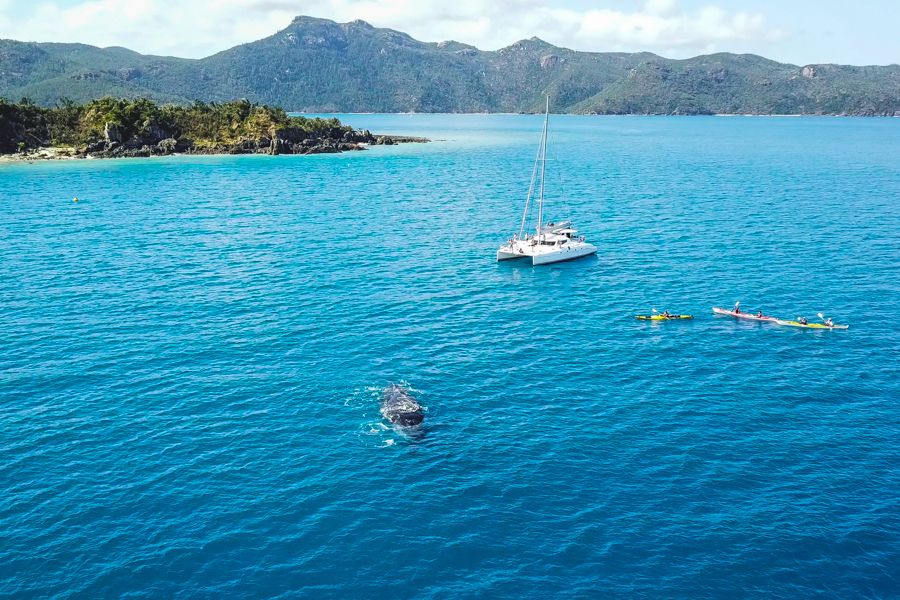
Contents
- When is whale season in the Whitsundays?
- Why do whales come to the Whitsundays in the winter?
- Humpback whales
- Identifying Humpbacks
- Whale biology
- Changes to Humpback migration
- Why the Whitsundays?
- Humpback whale behaviours
- Whale songs
- Famous sightings
When Is Whale Season In The Whitsundays?
Whale season in the Whitsundays starts in June and ends in early October, spanning the winter school holidays in Queensland. During this time, visitors on a sailing tour or private charter can spot whales frolicking through the warm Whitsunday waters with their young, making for a magical experience that every animal lover will remember forever!
Humpback Whale Migration on the East Coast
You will see humpback whales in the Whitsundays between June and October as they pass through on their northbound migration journey to give birth in warmer, tropical waters. In fact, a lot of whales will actually give birth to their calves in the Whitsunday waters, due to the calm, protected and warm conditions. Coming from down in Antarctic waters and travelling north all the way up to around Cairns, spot humpback whales playing with their newborn calves this whale season!

In addition to the humpback, you can spot several different types of marine mammals in the Whitsundays, including other cetaceans, such as pilot whales, dolphins, and porpoises, and sirenians like dugongs. Most of these can be found year-round in the protected waters of the islands and inner reef, but alas, the humpback only visits once a year, making it all the more special when we see them.

Why do whales come to the Whitsundays in winter?
Whales migrate north to the Whitsundays every winter so they can breed and raise their young in the perfect, tropical conditions. With its warm winter temperatures and calm waters protected by the reef and islands, the Whitsundays are an ideal location for female whales, most commonly humpback and pilot whales, to give birth to their calves every year.
Most whale sightings around the Whitsunday Islands are of a mother and her calf, either feeding or playing together, as well as pods of whales breaching at the surface as they move around. You can also spot adolescent males on their first migration back up north without mum! With consistent growth over the last ten years due to the abandonment of Whaling in the Southern Ocean, we look forward to future whale seasons beginning in June.

Humpback Whales
The humpback whale is a species of baleen whale, which means they filter feed by taking big lunges at their prey (mostly krill, small shrimp and fish) with their feeding apparatus, then push the water out of their brush-like baleen plates, much like a strainer. They don't feed while they are in the Whitsundays but instead do all of their feedings further down south, opting to fast during their journey.
These mammals can grow up to roughly 20 metres in length, weigh up to 45 tonnes, and live on average for 50 years, however, there has been documentation of them reaching as old as 100 years old! Being a mammal, they need oxygen to survive and utilise the blowhole on their backs to grab a quick breath without jumping out of the water, conserving energy for a big dive.

Identifying Humpbacks
Humpbacks are easily identifiable, and the most commonly spotted whale in Australia. Usually, they are black on top with a white underbelly, but the colouring ranges differently from animal to animal. They have large heads with a big mouth full of baleen, almost mimicking a wide grin.
You'll also notice bumps and barnacles adorning the gentle giants, as they cruise through the seas at a slow pace. They can have up to 22 throat pleats, which almost look like a ribbed sweater, which stretches the length of their underbellies, starting from their chins down to their large fluke, or tail. There is a small dorsal fin, and their pectorals (or flippers) are roughly a third of the length of their body!
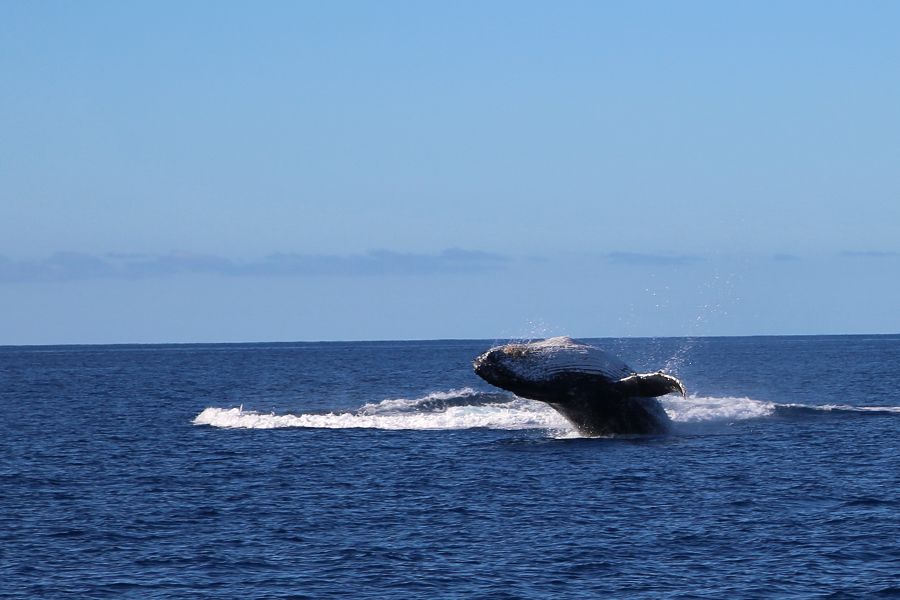
Whale Biology
Humpback whales are a large marine mammal, of the species cetacea. Humpbacks have unique biology in order to dive to depths of up to 200 metres. They are able to compress their lungs and shunt blood to essential organs during dives, and their muscles carry a high concentration of myoglobin. Whales' ribs are also flexible which assists with the pressure of diving. They give live birth to calves and produce milk.
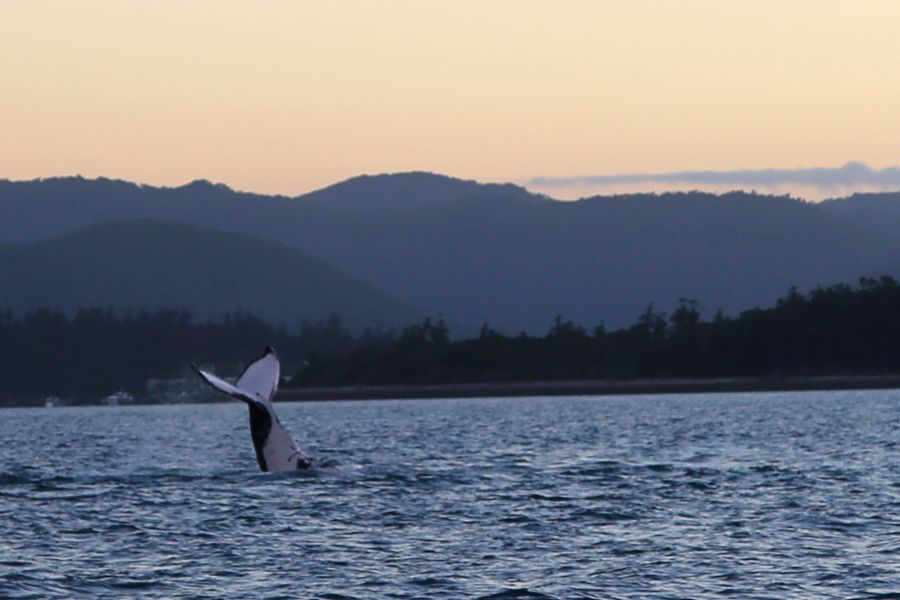
Changes To Humpback Migration
Every winter (or summer in the northern hemisphere), thousands of humpback whales migrate from the frigid waters of Antarctica where they've been filling up on krill, to bask in the warm, sub-tropical waters of the northeast coast of Australia. While 'whale season' in the Whitsundays has historically been the winter months from July to September, locals and seafarers have seen an increase in population over the last decade, meaning more are coming earlier and leaving later (think June to early October).
Some biologists speculate this could be due to rising temperatures in the ocean affecting their migratory patterns. It is also likely conservation efforts have been supporting this increase.
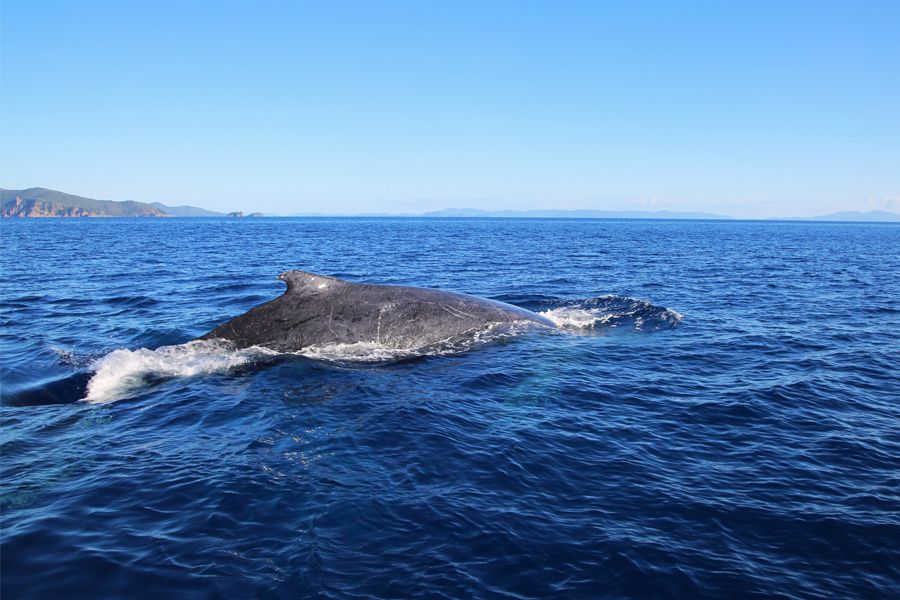
Why the Whitsundays?
The annual humpback migration dates back hundreds of thousands of years, however, it is difficult to tell if they have always kept the same pattern since the earth has changed so much. Pregnant cows will only give birth when the conditions to feed their young are favourable, and it appears the Whitsundays fits the bill perfectly!
Since temperatures average about 20 degrees Celcius (or 75-80 degrees Fahrenheit) between June and October, this warm cosy playground is the perfect place for them to stop and give birth in the protection of the islands and reefs.
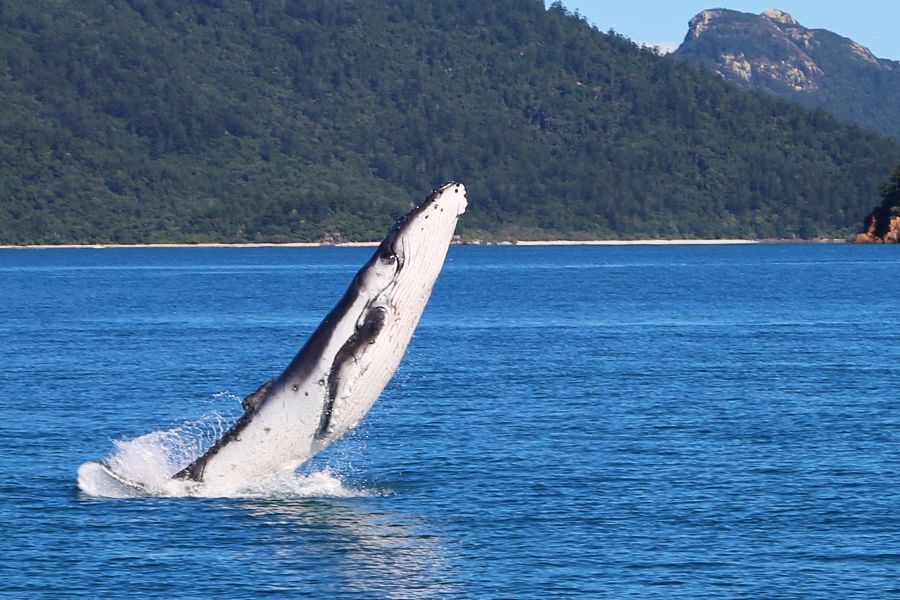
Humpback Whale Behaviours
Whales are complex creatures, with intricate social behaviour. Images of them breaching and puffs of water spouting from the air as they come up for air are wondrous sights to behold. You're likely to see them playing, diving, or slapping their fins as they frolic in the warm tropical waters of the islands. Some of the most common behaviours you'll see include the following:
Swimming
Although humpbacks can hold their breath for long periods of time, unlike humans they have to think about breathing, so they do not sleep. This is also why they tend to stay closer to the surface when they swim than other deep-diving whale species. Since their body mass is so huge, their pectoral fins are relatively slim in comparison, and mostly function as temperature regulators.
They propel themselves through the water with big tail fluke kicks and can leave a 'trail' also referred to as a 'slick' from these motions on the surface of the water. Humpback whales can swim up to 25 km per hour, however, they can slow to 2 km per hour for activities such as feeding.
Diving
Humpback whales can dive up to 200 metres, and stay underwater for up to 30 minutes, although usually, you'll find them under for less time than that. If you encounter one in the wild and they dive down, keep your eyes peeled, you might see them again very soon! Diving is usually preceded by a 'round out', in which a whale takes one last breath from its blowhole, rounding its body above the surface before disappearing underwater.
Breathing and Blowing
Baleen whales breathe through a pair of blowholes on their backs, and as air and mucus are forced out at speeds of up to 450km per hour, it creates bursts of mist in a vapour cloud. Particles of oil from the lungs are also present in these mists which can be seen from kilometres away. They have two nostrils on the tip of their head, and have also been known to snort!
Breaching
One of the most incredible surface behaviours these massive mammals display involves gaining enough momentum underwater to fully emerge from the water's surface, hurling their bodies into the air and performing acrobatic twists before landing in a spray of water. This behaviour is commonly associated with playing, however, there may be more practical reasoning behind the breach, such as eliminating pests from their bodies, communicating with other humpbacks, or gaining their bearings in association with the land. This is a common behaviour in humpbacks, especially when they are young. When out on a boat in the Whitsundays keep your eye out for a mum teaching her calf how to perform this gravity-defying stunt!
Spy Hop
Spy Hopping is when humpbacks bob their head above the water to get a closer look. This peek-a-boo behaviour usually comes as a gentle swim vertically to the surface until their eye is exposed. This is commonly seen in the Whitsundays when an inquisitive humpback wants to check out a boat that has stopped, or it can be another way to gain their bearings by scanning the horizon for land, similar to breaching.
Sleeping
Humpback whales do not ever fully sleep, as they are conscious breathers, however, scientists believe they can shut their brains down one side at a time to rest while the other side remains conscious. They can rest either vertically or horizontally, seemingly floating weightless, despite their girth. Female whales, much like humans, do not get much sleep (or half sleep) when their calves are first born, as they have to help their baby keep swimming. Calves aren't born with enough blubber to regulate their buoyancy, so it's up to mum to aid for the first few weeks of the newborn's life.
Feeding
Humpbacks filter feed on krill, small fish and plankton, taking massive gulps of water through their apparatus and pushing the water out through their baleen plates, which can be compared to broom bristles and are made of the same material as human fingernails. They can eat up to 2,500 kgs during their feeding season in the colder waters during summer, and store this energy in their blubber, or fat stores for their trek up north for mating and breeding season during the winter.
Mating
Mating occurs during their annual migration and is a competitive sport among males. Scientists have observed up to 10 males fighting for the females' affections and bulls are normally adorned with battle scars from this ritual. Whales are not monogamous and can breed on average every two to three years when fertile. Some scientists believe the whale's song is a key factor in mating season. It is rare to see humpbacks mating in the wild but it has been observed in the Whitsundays.
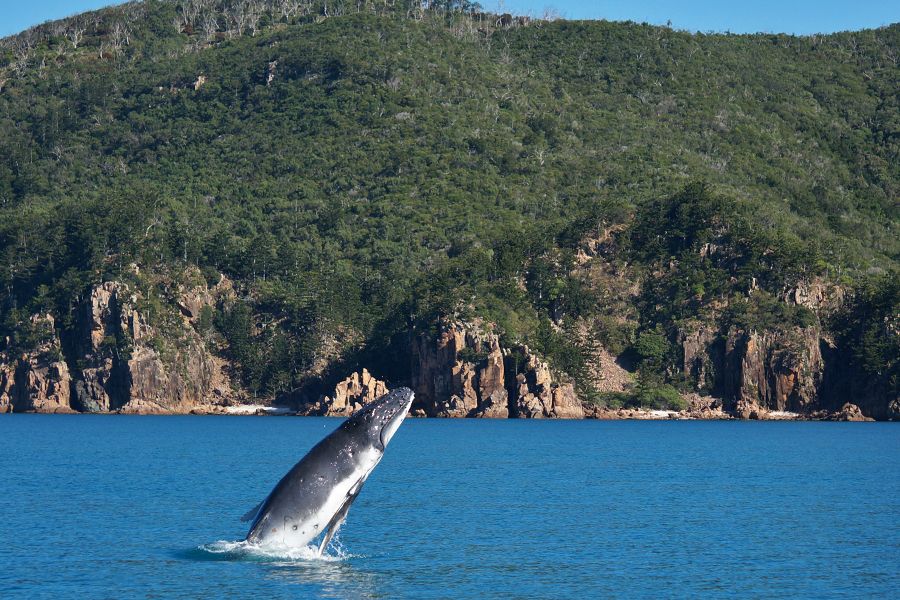
Whale Song
One of the most fascinating behaviours of the whale is their haunting song. This behaviour is exclusive to males, and they can actually orchestrate themselves to sing the same notes, proving to be a form of communication. Notes range from mimicking the deep hum of cellos to the high-pitched squeaks of violins, and they string them together in a wistful and melancholy melody.
Like humans, humpback whales have folds, or vocal cords, in their vocal boxes, and the sound comes from air moving through it. Whales only sing during migration and mating season and go quiet when they return to the Antarctic. They will pick up their songs from where they left off though upon their return up north.
Studies show noise from ships can cause whales to cease their song, but the smooth glide of a sailing yacht with the motor off seems to intrigue them, and they often come in closer to investigate. Sleeping overnight on a boat during whale season is a rare and magical experience, and these oceanic lullabies can often be heard when sleeping in a boat's hull.
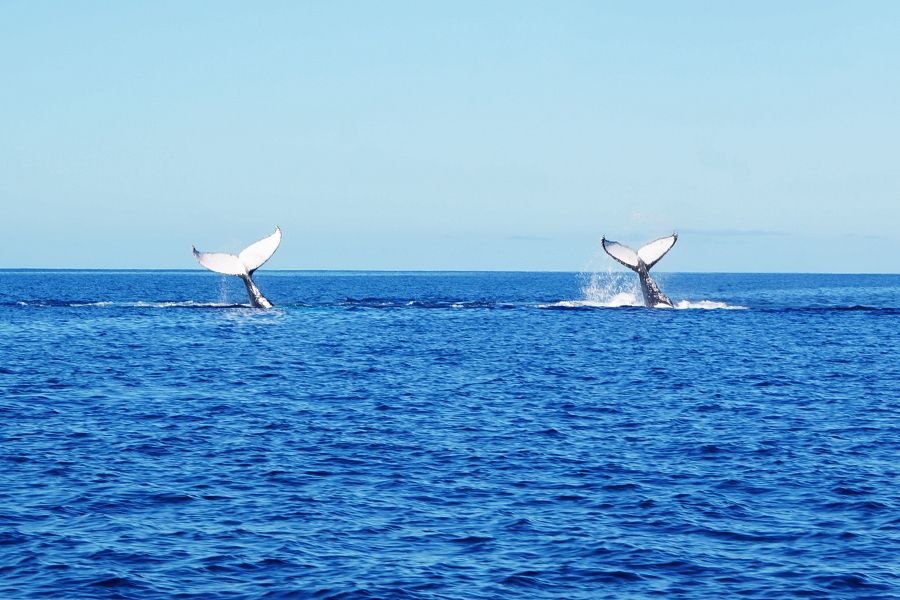
Famous sightings
- Migaloo the white humpback whale became famous for its rare colouring and has been spotted in the Whitsundays.
- Chalkie the white whale was born in the Whitsundays and is also a famous mammal.
For those who have never witnessed a whale in the wild, this is a once-in-a-lifetime experience and something you will always remember. There are strict regulations about how you can observe these fascinating creatures in the wild as they are a protected species.
How To See Whales In The Whitsundays
An overnight boat tour or private charter is the best way to see whales in the Whitsundays! As an added bonus during the peak winter months, whale sightings occur almost daily, on day and overnight tours around the Whitsundays islands, and occasionally on the Great Barrier Reef. Private charters allow you to have some influence over the itinerary, which can help your skipper prioritise whale watching if you wish.
Whales are often spotted out in the bays as you make your way around the islands, and have been known to breach or jump completely out of the water. Your crew will keep an eye out for whale activity and are sure to let you know if any of these beautiful animals are around.
Spot whales in the Whitsundays on a private charter!













